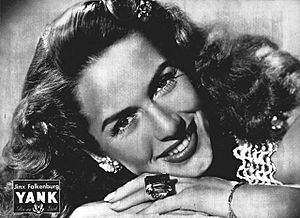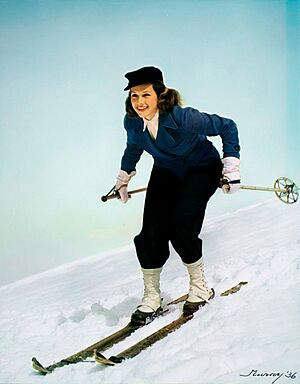Jinx Falkenburg facts for kids
Quick facts for kids
Jinx Falkenburg
|
|
|---|---|

Falkenburg in Yank, the Army Weekly (1945)
|
|
| Born |
Eugenia Lincoln Falkenburg
January 21, 1919 |
| Died | August 27, 2003 (aged 84) Manhasset, New York, U.S.
|
| Resting place | Ashes scattered at her farm residence in Duchess County, New York |
| Nationality | American |
| Occupation |
|
| Years active | 1937–1975 |
| Political party | Republican |
| Spouse(s) | |
| Children | 2 |
Eugenia Lincoln "Jinx" Falkenburg (born January 21, 1919 – died August 27, 2003) was a famous American actress and model. She married a journalist named Tex McCrary in 1945. Together, they became known as "Tex and Jinx." They were pioneers in creating and making the talk show format popular, first on radio and then on early television. They hosted many interview shows in the late 1940s and early 1950s. These shows mixed fun chats with celebrities and important discussions about the news of the day.
Contents
Early Life and Family
Jinx Falkenburg was born in Barcelona, Spain. Her parents were Americans. Her father, Eugene "Genie" Lincoln Falkenburg, was an engineer. Her mother, Marguerite "Mickey" Crooks Falkenburg, was a great athlete and tennis player. She was even the women's tennis champion in Brazil in 1927. Jinx's mother gave her the nickname "Jinx" because she thought it would bring good luck, and the name stuck!
All the Falkenburg children were known for their tennis skills. Jinx's younger brother, Bob Falkenburg, won the men's singles championship at Wimbledon in 1948.
The family later moved to Santiago, Chile, where Jinx spent her early years. She first got attention from the media when she was only two years old. The New York Sun newspaper published a big picture and story about her amazing swimming as a baby. After a revolution in Chile, her family moved back to the United States. They settled in Los Angeles, California. Jinx went to Hollywood High School but left in 1935, at age 16, to start a career in acting and modeling.
Becoming a Star
Acting and Modeling Career
The Falkenburg family was part of a popular group of young people at the West Side Tennis Club in Hollywood. While playing tennis there, Jinx was noticed by a talent scout from Warner Bros.. She signed a contract with the studio. After a few small roles, her ability to speak Spanish helped her get minor parts in Spanish-language films. These movies were made for audiences in Latin America.
In 1937, Jinx's modeling career really took off. She met a famous fashion photographer named Paul Hesse. His studio was a popular spot for advertising and movie industry stars. Paul Hesse called her "the most charming, most vital personality" he had ever photographed. He took her picture for the August 1937 cover of The American Magazine. This led to offers from 60 other magazines!
Jinx Falkenburg appeared on over 200 magazine covers and in about 1,500 advertisements in the 1930s and 1940s. People thought she was one of the most beautiful women of her time. She was known for her healthy, athletic "All-American-Girl" look. The New Yorker magazine said she had "one of the most photogenic faces and frames in the Western world." The New York World-Telegram said her face was seen more often than any other woman's in the country. A Life magazine story in 1941 even called her "the leading candidate for America's No. 1 Girl for 1941."
In 1939, while posing for photos in Hawaii, Jinx had an accident. She fell through a balcony at the Royal Hawaiian Hotel and landed on a dining room table 30 feet below. While recovering in the hospital, she met singer Al Jolson. He offered her a role in his Broadway show Hold On to Your Hats, which started in January 1940. Even though her part as a cowgirl was small, she got a lot of attention. Fans started gathering at her dressing room door every night. This group became the Jinx Falkenburg Fan Club, the only national fan club not for a movie star.
Her biggest modeling success came in 1940. She was chosen by Liebmann Brewery, which made Rheingold Beer, to be the first Miss Rheingold. Her picture was on billboards all over New York, Pennsylvania, and New England. She was also featured in ads at every store that sold Rheingold. Her face and the ad campaign were a huge hit, and Rheingold quickly became the top beer brand in New York City.
In the early 1940s, Jinx made about a dozen movies, mostly for Columbia Pictures. Sometimes she had the main role. Most of these were "B movies," which are lower-budget films. Neither the movies nor her acting received much praise from critics. One of her biggest movies was Cover Girl, a musical about the modeling business. It starred Rita Hayworth and had songs by Jerome Kern and Ira Gershwin. Jinx Falkenburg played herself in a small appearance.
Tex and Jinx: Radio and TV Stars
Jinx Falkenburg met John Reagan "Tex" McCrary when he came to interview her for a military magazine. He was a lieutenant colonel in the Army Air Forces. They were going to get engaged in 1942, but World War II started. They married after the war on June 15, 1945.
During World War II, Jinx traveled a lot on USO tours. She entertained soldiers in many places, including a tough 42,000-mile tour with 80 shows in China, Burma, and India. In 1945, she received a special medal for her help during the war.
After the war, Tex McCrary convinced David Sarnoff, the head of NBC, to give him and Jinx a morning show on NBC's New York radio station, WEAF. The show was called Hi, Jinx and started on April 22, 1946. People liked the show because it had "sprightly" (lively) talks and sometimes "intense discussions of foreign affairs." Newsweek magazine wrote about them, saying Tex would say "Hi, Jinx" and Jinx would answer, "Hello Tex." Over time, they became known as "Mr. Brains and Mrs. Beauty."
Their radio show was on five mornings a week and became very popular. They talked about important topics like the atomic bomb and the United Nations. They also discussed new theater shows and New York nightlife. Their guests included famous entertainers like Mary Martin and Esther Williams, and important public figures like Eleanor Roosevelt and Margaret Truman.
Tex McCrary wrote the scripts and taught Jinx how to interview people and the basics of broadcast journalism. Many thought Jinx became the better interviewer. She was good at getting honest answers, especially from the more intellectual guests. Her style was to keep asking questions until she understood the answer. This meant that the housewives listening at home would also understand. A New York Times writer, William Safire, said they "developed an audience that was ready to start thinking at breakfast."
In January 1947, Tex and Jinx got their first network TV show, Bristol-Myers Tele-Varieties. It was also called Jinx and Tex at Home. It aired on Sunday nights on NBC. The show mixed film clips with live interviews of celebrities in their homes. Another radio show, Meet Tex and Jinx, became so popular that in 1947 and 1948, it took the place of one of radio's most famous shows, Duffy's Tavern, during the summer.
In the winter of 1948, Jinx traveled to Berlin, Germany, during the Berlin Airlift. This was when the city was blocked by the Russians, and supplies had to be flown in by Allied planes. She flew in with comedian Bob Hope and songwriter Irving Berlin to perform Christmas shows for the airmen and soldiers.
Tex and Jinx became even more popular. In the early 1950s, they hosted two radio shows and a daily television show. They also wrote a newspaper column for the New York Herald Tribune. Some of their shows were broadcast from the Peacock Alley restaurant in the famous Waldorf-Astoria Hotel.
Jinx often did interviews outside the studio with her tape recorder and microphone. She covered many big news stories of the day. These included the coronation of Queen Elizabeth II in London and the wedding of Grace Kelly to Prince Rainier of Monaco. In 1958, she was the only female reporter on the plane that went with Vice President Richard Nixon on his trip to South America. She also appeared on camera in the historic "kitchen debate" in Moscow between Nixon and Soviet leader Nikita Khrushchev.
Involvement in Politics
In 1952, Tex McCrary led a campaign to get General Dwight D. Eisenhower to run for president as a Republican. A big moment in this effort was a "Citizens for Eisenhower" rally at Madison Square Garden. Jinx and Tex organized and hosted this three-hour event.
In 1954, Jinx became the head of the women's division of the finance committee for the Republican Party. She continued to serve on this committee and remained a Republican throughout her life. She sometimes helped the party with its causes.
Later Years and Personal Life
Jinx Falkenburg mostly retired from broadcasting in 1958. She continued to live in Manhasset, New York. In 1962, she and Tex McCrary hosted 16 weeks of coverage for the Billy Graham Crusade for Christianity. In the early 1960s, Jinx was a spokesperson for the American Gas Association. She also became a vice-president for a cosmetics company.
Jinx and Tex McCrary had two sons, John Reagan "Paddy" McCrary III and Kevin Jock McCrary.
Jinx remained athletic even as she got older. She started playing golf at age 40 and quickly became very good. In 1975, at age 56, she was part of a celebrity team that played a tennis match at Forest Hills before the start of the U.S. Open.
Jinx Falkenburg was a Roman Catholic. In 1980, Jinx and Tex separated but never officially divorced. They remained friends. Tex McCrary died on July 29, 2003, at age 92, less than a month before Jinx.
Jinx was also involved in charity work. She was on the board of the North Shore University Hospital in Manhasset, which her husband helped build.
Jinx Falkenburg passed away on August 27, 2003, at the age of 84 at North Shore University Hospital in Manhasset. She was cremated.
Legacy
For her important work in the television industry, Jinx Falkenburg has a star on the Hollywood Walk of Fame at 1500 Vine Street.
Fictional Depiction
Jinx Falkenburg appears as a character in books #1-3 of a French graphic-novel series called Angel Wings. These books are set during World War II in Burma.
Selected Filmography
- She Has What It Takes (1943)
- Two Señoritas from Chicago (1943)
- Cover Girl (1944)


